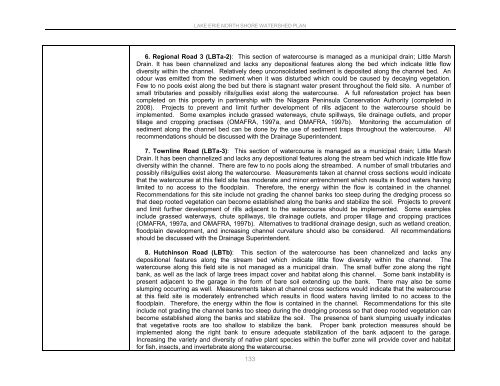Lake Erie North Shore Watershed Plan - Niagara Peninsula ...
Lake Erie North Shore Watershed Plan - Niagara Peninsula ...
Lake Erie North Shore Watershed Plan - Niagara Peninsula ...
Create successful ePaper yourself
Turn your PDF publications into a flip-book with our unique Google optimized e-Paper software.
LAKE ERIE NORTH SHORE WATERSHED PLAN<br />
6. Regional Road 3 (LBTa-2): This section of watercourse is managed as a municipal drain; Little Marsh<br />
Drain. It has been channelized and lacks any depositional features along the bed which indicate little flow<br />
diversity within the channel. Relatively deep unconsolidated sediment is deposited along the channel bed. An<br />
odour was emitted from the sediment when it was disturbed which could be caused by decaying vegetation.<br />
Few to no pools exist along the bed but there is stagnant water present throughout the field site. A number of<br />
small tributaries and possibly rills/gullies exist along the watercourse. A full reforestation project has been<br />
completed on this property in partnership with the <strong>Niagara</strong> <strong>Peninsula</strong> Conservation Authority (completed in<br />
2008). Projects to prevent and limit further development of rills adjacent to the watercourse should be<br />
implemented. Some examples include grassed waterways, chute spillways, tile drainage outlets, and proper<br />
tillage and cropping practises (OMAFRA, 1997a, and OMAFRA, 1997b). Monitoring the accumulation of<br />
sediment along the channel bed can be done by the use of sediment traps throughout the watercourse. All<br />
recommendations should be discussed with the Drainage Superintendent.<br />
7. Townline Road (LBTa-3): This section of watercourse is managed as a municipal drain; Little Marsh<br />
Drain. It has been channelized and lacks any depositional features along the stream bed which indicate little flow<br />
diversity within the channel. There are few to no pools along the streambed. A number of small tributaries and<br />
possibly rills/gullies exist along the watercourse. Measurements taken at channel cross sections would indicate<br />
that the watercourse at this field site has moderate and minor entrenchment which results in flood waters having<br />
limited to no access to the floodplain. Therefore, the energy within the flow is contained in the channel.<br />
Recommendations for this site include not grading the channel banks too steep during the dredging process so<br />
that deep rooted vegetation can become established along the banks and stabilize the soil. Projects to prevent<br />
and limit further development of rills adjacent to the watercourse should be implemented. Some examples<br />
include grassed waterways, chute spillways, tile drainage outlets, and proper tillage and cropping practices<br />
(OMAFRA, 1997a, and OMAFRA, 1997b). Alternatives to traditional drainage design, such as wetland creation,<br />
floodplain development, and increasing channel curvature should also be considered. All recommendations<br />
should be discussed with the Drainage Superintendent.<br />
8. Hutchinson Road (LBTb): This section of the watercourse has been channelized and lacks any<br />
depositional features along the stream bed which indicate little flow diversity within the channel. The<br />
watercourse along this field site is not managed as a municipal drain. The small buffer zone along the right<br />
bank, as well as the lack of large trees impact cover and habitat along this channel. Some bank instability is<br />
present adjacent to the garage in the form of bare soil extending up the bank. There may also be some<br />
slumping occurring as well. Measurements taken at channel cross sections would indicate that the watercourse<br />
at this field site is moderately entrenched which results in flood waters having limited to no access to the<br />
floodplain. Therefore, the energy within the flow is contained in the channel. Recommendations for this site<br />
include not grading the channel banks too steep during the dredging process so that deep rooted vegetation can<br />
become established along the banks and stabilize the soil. The presence of bank slumping usually indicates<br />
that vegetative roots are too shallow to stabilize the bank. Proper bank protection measures should be<br />
implemented along the right bank to ensure adequate stabilization of the bank adjacent to the garage.<br />
Increasing the variety and diversity of native plant species within the buffer zone will provide cover and habitat<br />
for fish, insects, and invertebrate along the watercourse.<br />
133
















